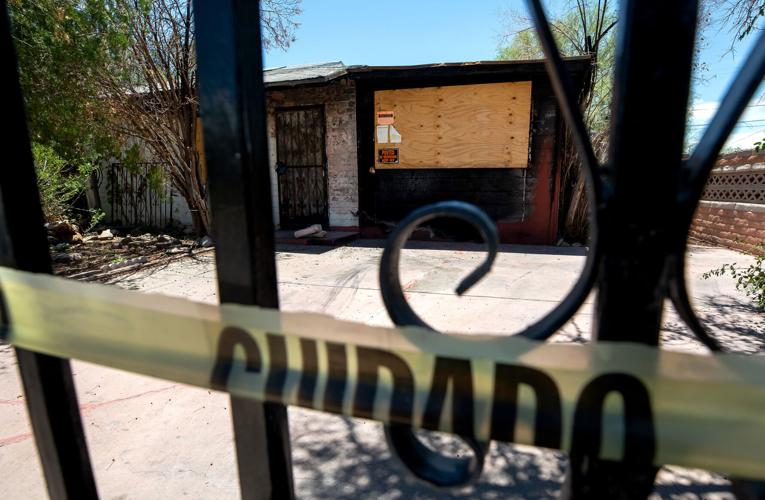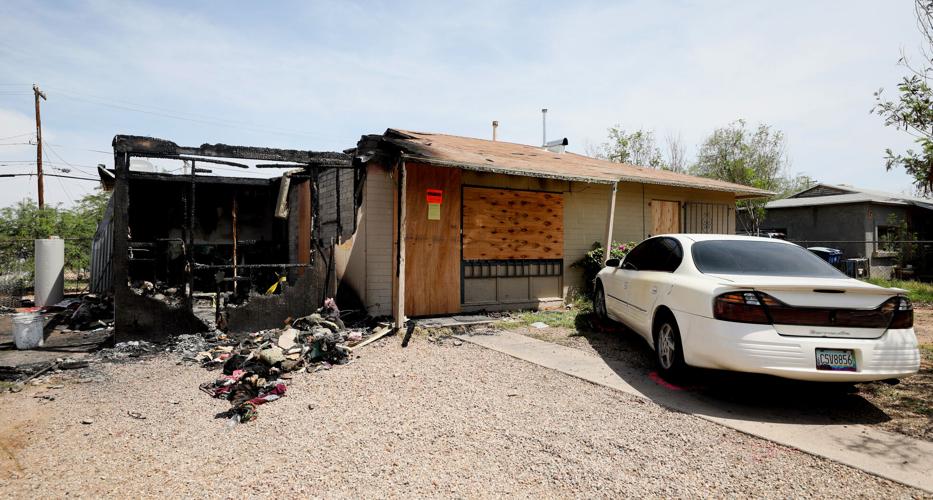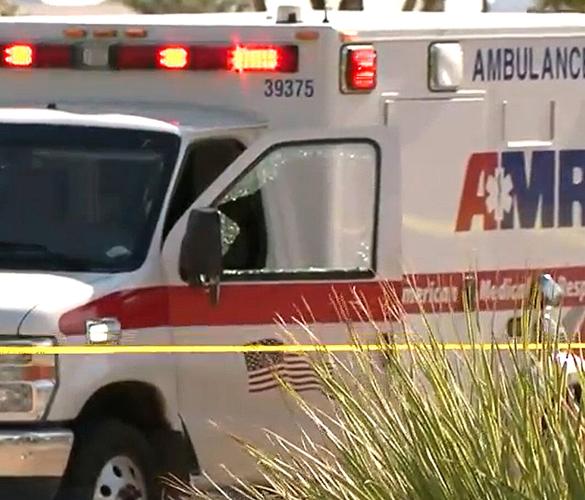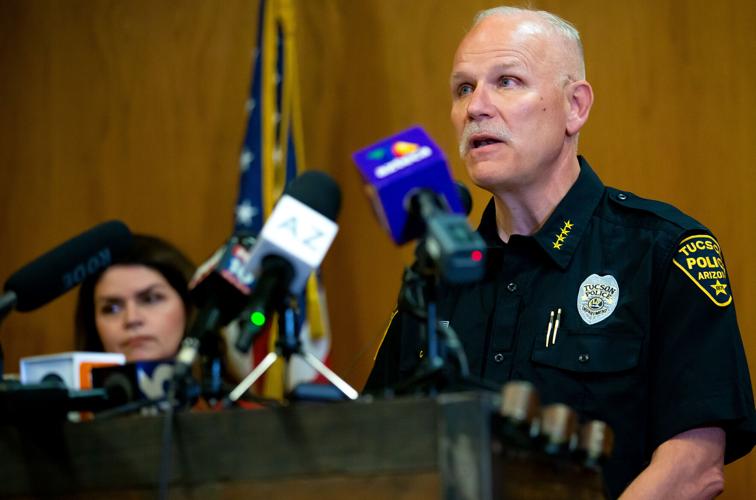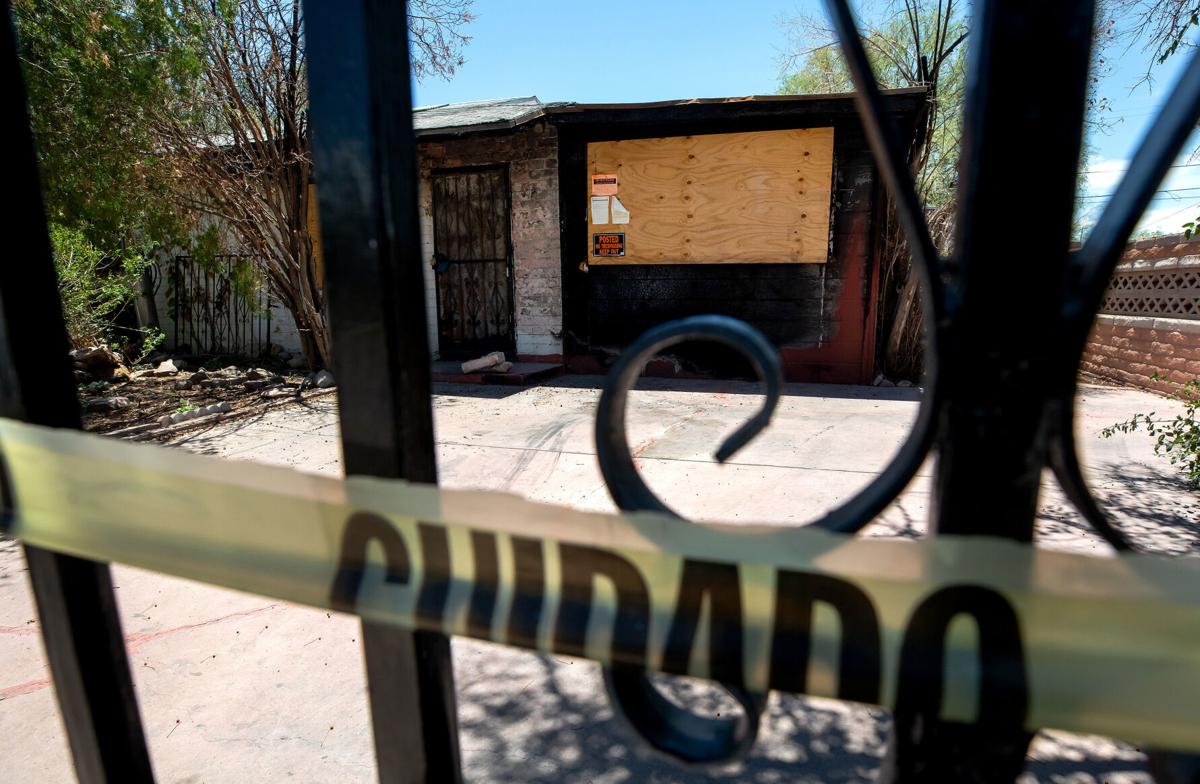The mental and emotional decline of the man who went on a deadly rampage in a Tucson neighborhood last weekend is bookended by a pair of house fires, investigators say.
In January, Leslie Scarlett’s mother, Ruth Monica Scarlett Webb, was killed in a house fire on East Irene Vista, the same street where firefighters and neighbors came under attack Sunday. A few months later, Richard Harwell Jr. died of complications from the same house fire, records show.
Tucson Police Chief Chris Magnus gave an update at Monday afternoon on the shooting attacks Sunday on the city’s south side, in which one person was shot to death and several others — including 2 paramedics and a firefighter - were wounded.
Scarlett, 35, was seriously burned trying to save his mother and Harwell from the burning home. He was hospitalized for weeks.
Faulty wiring was later determined to be the case of the fatal fire.
The house fire appears to have triggered a decline in Scarlett’s mental health, police said late this week, as they worked to figure out the details and motive for Scarlett shooting his girlfriend, Jennifer A. Fells, then setting the house on fire. Scarlett then shot two EMTs at a nearby park before he returned to the burning house and opened fire on firefighters and neighbors, shooting neighbor Corey Saunders to death.
Scarlett was critically wounded in a gunfight with a police officer and died Wednesday.
“This does not take away from any of the horrific actions he committed on Sunday, but in many ways, he is a tragic figure himself, because this is somebody that obviously had some very serious problems and who was devolving over a period of time,” Tucson Police Chief Chris Magnus said Thursday. “This notion that there are good guys and bad guys is sometimes made far more complicated by the area of mental health and what’s going on in some of these folks’ lives, and this does appear to be a person who was really going through a pretty serious mental health crisis.”
"Like a lion roaring"
The blackened shells of two burned out houses on the 2100 block of East Irene Vista were impossible to miss Monday morning. The ranch-style houses across the street from each other in the Western Hills subdivision near South Kino Parkway and East 36th Street looked eerily similar, even though the fires were separated by seven months.

Leslie Scarlett
The house where Scarlett’s mother lived was engulfed in flames by the time firefighters arrived the night of Jan. 7, Star archives show.
On that night, Scarlett ran from his house across the street, past firefighters and into the flames at his mom’s burning home.
“He was like, ‘No, Mamma!’” said Belinda Railey, a longtime neighbor. “You could hear his voice like a lion roaring.”
Harwell, Webb and Scarlett were all critically injured when they were taken to the hospital, reports show.
Potential defects in electrical wiring were later determined to be to blame for the blaze, police say.
Webb died from smoke inhalation two days after the fire, according to her autopsy report.
Scarlett spent about a month in the hospital, Railey said. The burns reportedly covered 80% of his body.
On Feb. 14, Scarlett wrote on his mother’s online memorial, “My mother was a migrant to America a woman who taught me how to love and learn and think outside the box...Ruth Webb a woman of determination — explorer by her on right, God driven woman always had kind words.”
Harwell died weeks after the fire on Feb. 26.
A month later, police were called to Scarlett’s neighborhood after complaints of a man walking through yards, yelling, “Fire! Fire!”

House at 2141 E. Irene Vista that was on fire when Leslie Scarlett attacked neighbors and firefighters. Cory Saunders was killed. Scarlett’s girlfriend was found dead inside the house.
"Leslie had been struggling lately"
Officers arrived on March 27 to find Scarlett walking around his front yard.
He didn’t acknowledge officers and they tried to detain him, according to a TPD report from the incident.
Scarlett resisted at first.
He was handcuffed after a brief struggle. Then Fells came outside to talk to the police, identifying herself as Scarlett’s fiancée.
Fells told police that Scarlett was having “personal problems” since with the recent death of his parents, and sharing that he’d pulled them from the burning house.
“Jennifer said Leslie was most likely relapsing, and suffering from PTSD from the incident,” the police report reads. “Jennifer said Leslie had been struggling lately, which has been progressively getting worse over the last few days.”
Officers took Scarlett to the Crisis Response Center, a 24-hour facility that provides mental health evaluations and services.
The encounter that night was classified as a mental health case rather than a criminal call.
What happened next is unknown, which police now say is a problem.
"What happened from there?"
A person going to the crisis center moves the case to mental and behavioral health services, said Lt. Stacie Schaner.
“It really only comes back to us if we have continued calls for services, which in this case we didn’t, or there’s a revocation or change to a court order,” Schaner said. “Otherwise once they’re handed over, if there’s no other flags or triggers, there’s not necessarily communication back to us.”
Scarlett had been working at a plumbing company before the fire that killed his mom. Employees say he did not return to work after the fire.
The police report in March showed Scarlett listing his employer as KFC.
“It seems that from the outside looking in, the fire and the death of his parents was a trigger, and that’s where things started to go downhill,” said Assistant Chief Kevin Hall.
But nothing Scarlett did triggered any flags with TPD. That means he wasn’t on the department’s radar before Sunday’s violent rampage.

Shattered glass on the driver’s side of an AMR ambulance in a park near 36th Street and Kino Parkway, where two EMTs were ambushed July 18. The driver was killed. The shooter, Leslie Scarlett, was killed by TPD Officer Danny Leon.
“The question is what happened after he completed his treatment. What happened from there? Was there follow-up?” Magnus said.
“Perhaps if there had been more follow-up after his sort of breakdown, there might have been more indications of that. I have a feeling there were other indications that would have been evident that this man was really declining.”
It’s unusual in mass shootings cases in the U.S. for there not to be a noticeable decline in the behavioral health of the shooter, Hall said.
TPD still doesn’t know the details of Scarlett’s mental health treatment, and has received no information about follow-up care after initially being taken to the crisis center.
They also don’t know if there were visits to Scarlett’s home or if he refused services.
Magnus said the weekend attack highlights the need for improvements in several areas, including fixing the communication gap between law enforcement and behavioral and mental health providers.
“That’s the true value of a co-responder model where you have mental health clinicians or workers with police, either riding with them, responding with them or working with them in some fashion,” Hall said “It’s that sort of enhanced communication between behavioral health and law enforcement, then they can do a much better risk assessment.”

Tucson Police Chief Chris Magnus, right, speaks during a press conference at Tucson Police Department Headquarters about the shooting involving Leslie Scarlett. Mayor Regina Romero is background left.
Magnus said the co-responder model allows for protection of patient rights, but also puts first responders in a better position to recognize problems and to address them in a more thoughtful way. There’s been some discussion in the past of implementing the model in Tucson, but no action has been taken.
Now, police have to call the crisis line to gather information about someone’s mental health status or history.
“This (situation) is really about how somebody like this is tracked in the system and how information is shared between the mental health side of it and the criminal justice side of it,” Magnus said. “This is a person that I think seems to have gotten lost somewhere over there.”
Luis Bravo describes the scene on Irene Vista in Tucson as neighbors and Tucson firefighters were ambushed by a gunman on Sunday, July 18. Video by Rebecca Sasnett / Arizona Daily Star 2021
Photos: Vigil honors victims of Tucson shooting rampage
Community Vigil
Updated
Carmelita Sanchez, center, holds a photo of Jennifer Fells during a community vigil organized by Homicide Survivors at the MSA Annex, 267 S. Avenida del Convento in Tucson, on July 21, 2021. The vigil is to honor those killed and wounded in Sunday's south-side house fire and shooting spree. Fells, a mother of three, was shot and her body was found in a house that burned Sunday just before the other shootings started. Sanchez worked with Fells at a McDonald's restaurant.
Community Vigil
Updated
Melissa Snyder, right, girlfriend of Cory Saunders, becomes emotional as she talks with Paloma Sainz, a victim's advocate, during a community vigil organized by Homicide Survivors at the MSA Annex, 267 S. Avenida del Convento in Tucson, on July 21, 2021. The vigil is to honor those killed and wounded in Sunday's shooting. Saunders was shot and killed while helping to respond to a house fire in his neighborhood.
Community Vigil
Updated
Melissa Snyder, right, girlfriend of Cory Saunders, hugs Rachel Smith, during a community vigil organized by Homicide Survivors at the MSA Annex, 267 S. Avenida del Convento in Tucson, Ariz. on July 21, 2021. The vigil is to honor those killed and wounded in Sunday's shooting.
Community Vigil
Updated
Corrine Dindinger looks at her husband, Jim, parents of Jacob Dindinger, as they meet with co-workers of Jennifer Fells, during a community vigil organized by Homicide Survivors at the MSA Annex, 267 S. Avenida del Convento in Tucson, on July 21, 2021. The vigil is to honor those killed and wounded in Sunday's shooting. Fells was shot and her body was found in a burned house, and Jacob Dindinger, an emergency medical technician, was shot and is in critical condition.
Community Vigil
Updated
Members of the Four Wind Drum group perform a ceremonial song during a community vigil organized by Homicide Survivors at the MSA Annex, 267 S. Avenida del Convento in Tucson, Ariz. on July 21, 2021. The vigil is to honor those killed and wounded in Sunday's shooting.
Community Vigil
Updated
Jeff Smith, cousin of Cory Saunders, looks down at his candle as Rachel Smith helps Melissa Snyder, Saunders' girlfriend, light her candle during a community vigil organized by Homicide Survivors at the MSA Annex, 267 S. Avenida del Convento in Tucson, on July 21, 2021. The vigil is to honor those killed and wounded in Sunday's shooting. Saunders was shot and killed while trying to help put out a house fire in his neighborhood.
Community Vigil
Updated
Andy Dindinger, uncle of Jacob Dindinger, speaks during a community vigil organized by Homicide Survivors at the MSA Annex, 267 S. Avenida del Convento in Tucson, on July 21, 2021. The vigil is to honor those killed and wounded in Sunday's shooting. Jacob was shot four times and is in critical condition.
Community Vigil
Updated
Cristobal Mireles, co-worker of Jennifer Fells, speaks during a community vigil organized by Homicide Survivors at the MSA Annex, 267 S. Avenida del Convento in Tucson, on July 21, 2021. The vigil is to honor those killed and wounded in Sunday's house fire and shooting spree.
Community Vigil
Updated
Michael Runyan, center, brother of Jennifer Fells, speaks during a community vigil organized by Homicide Survivors at the MSA Annex, 267 S. Avenida del Convento in Tucson, on July 21, 2021. The vigil is to honor those killed and wounded in Sunday's house fire and shooting spree. Ty Russell, left, and Kelly Woodard stand by Runyan.


